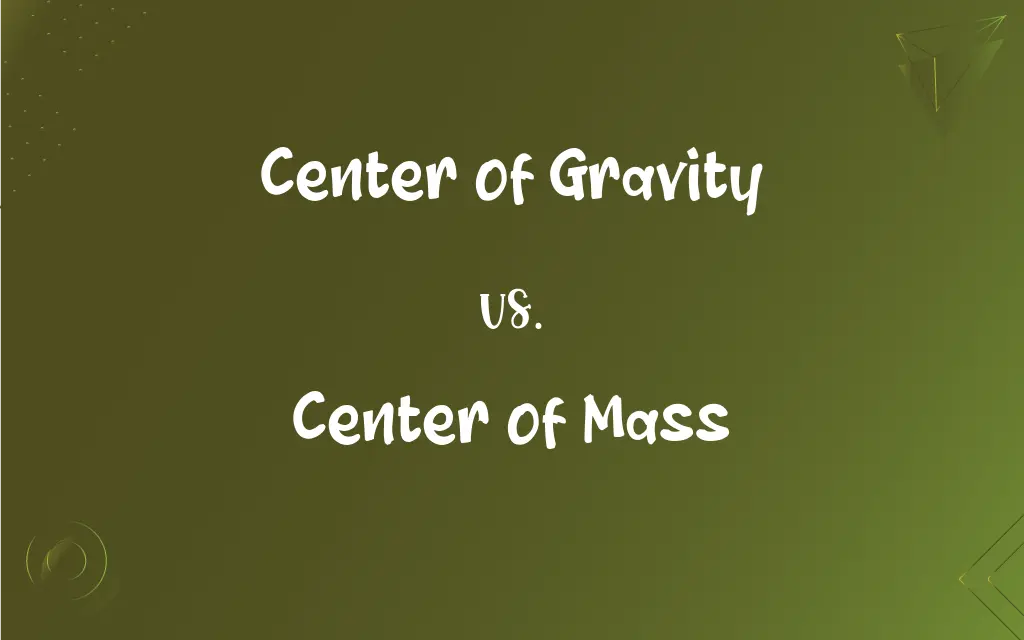Center of Gravity vs. Center of Mass: What's the Difference?
Edited by Aimie Carlson || By Harlon Moss || Updated on October 16, 2023
Center of gravity is a point where gravitational forces act; center of mass is a point representing average location of mass.

Key Differences
Center of gravity is the point where the weight of an object is balanced, while center of mass is the average position of all particles of mass.
The center of gravity takes into account gravitational forces, whereas the center of mass depends solely on distribution of mass.
In a uniform gravitational field, the center of gravity coincides with the center of mass; otherwise, they might differ.
For many practical applications on Earth's surface, center of gravity and center of mass can be used interchangeably.
In outer space, where gravity is negligible, only the center of mass is relevant.
ADVERTISEMENT
Comparison Chart
Definition
Point where gravitational forces act
Point representing average location of mass
Gravitational Dependence
Affected by gravity
Independent of gravity
Relevance on Earth
Often matches center of mass
Always a fixed point regardless of gravitational effects
Application in Space
Less relevant
More pertinent
Dependence on Object's Shape
Can shift based on object's orientation in a gravitational field
Always remains at the same position regardless of orientation
ADVERTISEMENT
Center of Gravity and Center of Mass Definitions
Center of Gravity
Varies with object's orientation in non-uniform gravity.
A tilted seesaw's center of gravity shifts towards the heavier end.
Center of Mass
It's independent of gravitational forces.
In space, the center of mass of an object remains unchanged.
Center of Gravity
It's where gravitational forces act.
The center of gravity of the pendulum is where it experiences the pull of Earth.
Center of Mass
For symmetric objects, it's at the geometric center.
The center of mass of a rectangle is its midpoint.
Center of Gravity
Determines the object's stability.
A low center of gravity makes the car more stable on turns.
Center of Mass
Describes rotational dynamics.
Spinning ice skaters adjust their center of mass to control their speed.
Center of Gravity
Center of gravity is the balance point of an object.
The center of gravity of a seesaw is its midpoint.
Center of Mass
Center of mass denotes average position of all mass particles.
The center of mass of a molecule lies where its mass is evenly distributed.
Center of Gravity
For symmetrical objects, it lies at the geometric center.
The center of gravity of a perfect sphere is its exact middle.
Center of Mass
It remains fixed regardless of the object's orientation.
Regardless of its spin, a top's center of mass stays constant.
FAQs
Do the center of gravity and center of mass always align?
In a uniform gravitational field, yes; otherwise, they can differ.
Does the center of mass move with the object's orientation?
No, it remains constant regardless of orientation.
Where is the center of gravity for symmetrical objects?
It's usually at the geometric center.
What is the center of gravity?
It's the point where an object's weight is perfectly balanced or where gravitational forces act.
Is that the same for the center of mass?
Yes, for symmetrical objects, it's at the geometric center.
How is stability related to the center of gravity?
A lower center of gravity often results in greater stability.
Why is center of gravity important in engineering?
It helps determine stability and balance in structures and vehicles.
How about the center of mass in physics?
It's crucial for understanding motion, rotational dynamics, and more.
Are there calculations to determine these centers?
Yes, there are mathematical formulas based on mass and volume distributions.
Is the center of mass always a fixed point on an object?
Yes, it doesn't change with the object's orientation.
Is center of mass affected by gravity?
No, it's independent of gravitational forces.
Can an object's center of gravity change based on its orientation?
Yes, especially in non-uniform gravitational fields.
Is that possible for the center of mass too?
Yes, the center of mass can also lie outside the physical material of an object.
Does the center of mass play a role in sports?
Yes, athletes often adjust their center of mass to enhance performance.
And the center of mass?
It's the average position of all the particles of mass in an object.
Is the center of mass used in rotational dynamics?
Yes, it describes how objects rotate and revolve.
How is center of mass defined in space?
It remains the average location of an object's mass, unaffected by gravity.
Can center of gravity and center of mass be used interchangeably on Earth?
Often, but not always—especially in varying gravitational fields.
Can the center of gravity lie outside the object?
Yes, like in a donut where it's at the center, but not within the material.
Does the center of gravity have the same weight in all directions?
Yes, it's the point where weight is evenly distributed in all directions.
About Author
Written by
Harlon MossHarlon is a seasoned quality moderator and accomplished content writer for Difference Wiki. An alumnus of the prestigious University of California, he earned his degree in Computer Science. Leveraging his academic background, Harlon brings a meticulous and informed perspective to his work, ensuring content accuracy and excellence.
Edited by
Aimie CarlsonAimie Carlson, holding a master's degree in English literature, is a fervent English language enthusiast. She lends her writing talents to Difference Wiki, a prominent website that specializes in comparisons, offering readers insightful analyses that both captivate and inform.































































